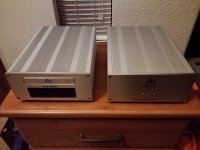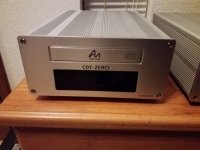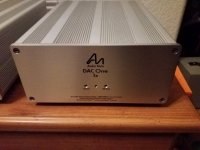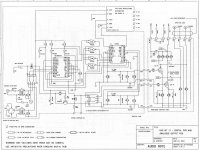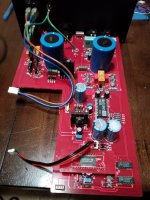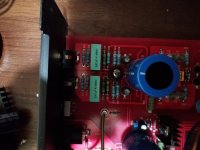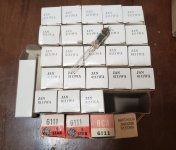I've acquired some Audio Note pieces and was curious if they're anything significant worth holding onto.
The CD transport model is CDT-Zero and the D/A is DAC-One 1X. There are no transport control buttons on the CDT. Everything has to be controlled via IR remote which is rather strange.
A quick listen shows the pair to be very analog sounding, sort of like that TDA1541 NOS sort of vibe, but more vivid and with better, tighter low end. Vocals are more forward and present with a well defined sound stage I believe they use a pair of 6111WA dual triodes in the output buffer stages, which explains the improved sound with it warming up, playing for a while. Compared to my RME Pro2 FSR running in NOS mode, it has some striking similarities. Mind you, the RME is no slouch and holds its own compared to some $5k DACs I've heard. The Audio Note DAC is a decent sounding piece of gear. Not sure what to do with it having a few other comparable DACs and transports.
The CD transport model is CDT-Zero and the D/A is DAC-One 1X. There are no transport control buttons on the CDT. Everything has to be controlled via IR remote which is rather strange.
A quick listen shows the pair to be very analog sounding, sort of like that TDA1541 NOS sort of vibe, but more vivid and with better, tighter low end. Vocals are more forward and present with a well defined sound stage I believe they use a pair of 6111WA dual triodes in the output buffer stages, which explains the improved sound with it warming up, playing for a while. Compared to my RME Pro2 FSR running in NOS mode, it has some striking similarities. Mind you, the RME is no slouch and holds its own compared to some $5k DACs I've heard. The Audio Note DAC is a decent sounding piece of gear. Not sure what to do with it having a few other comparable DACs and transports.
Attachments
I believe the DAC One uses a single AD1865 (NOS) and a tube output stage hence the great sound. Take the cover off and see what's inside!
I built a Dac 1 kit some years ago and was charmed by the sound but I preferred my dual balanced TDA1541 with transformer output.
I built a Dac 1 kit some years ago and was charmed by the sound but I preferred my dual balanced TDA1541 with transformer output.
Attachments
Yes, I need to open them both up and do some basic maintenance. I'm sure the tube needs replacing due to the slow warmup. The front panel on the DAC says its 18 bit / 96k capable with no oversampling. I did hear that you can sub an ECC82 for the 6111WA. Not sure about that one.
Yes, the AD1865 is an 18bit dac and with no oversampling in the Dac 1.Yes, I need to open them both up and do some basic maintenance. I'm sure the tube needs replacing due to the slow warmup. The front panel on the DAC says its 18 bit / 96k capable with no oversampling. I did hear that you can sub an ECC82 for the 6111WA. Not sure about that one.
12AU7 is same as ECC82, not sure about the 6111WA - don't think it is an alternative as it's described as a subminiature twin triode (8 wires no pins) used in microphone preamps although I see on the front of the dac that a 6111WA is used.
The 6111 is soldered in place. The heater currents aren't the same as the ECC8x series valves, so I guess it was just another piece of internet blabber regarding the compatibility.
I'll be pulling these apart soon, so I can decide what to do with them. It looks like the transport is a Sony setup. I usually prefer philips CDM based transports due to their tracking ability, but the Sony stuff isn't too bad. My NEC CD730 is Sony based and dual differential TDA1541A. It doesn't track as well as my other swing arm CDMs.
I'll be pulling these apart soon, so I can decide what to do with them. It looks like the transport is a Sony setup. I usually prefer philips CDM based transports due to their tracking ability, but the Sony stuff isn't too bad. My NEC CD730 is Sony based and dual differential TDA1541A. It doesn't track as well as my other swing arm CDMs.
The question is, which brand of 6111wa is the best sounding and where is a good source to purchase from.
I use Watfordvalves.com for mine:The question is, which brand of 6111wa is the best sounding and where is a good source to purchase from.
https://www.watfordvalves.com/search.asp?search=6111wa&Submit=Search
I've been listening to the DAC some more and I'm falling in love, specifically with the immediacy and detail in the midrange. The low end and treble aren't far behind - all this on a well worn buffer tube that is showing some signs of needing replacing. As a whole, I'm seeing the beauty in the simplicity of this converter and how it would be easy to go down a rabbit hole of upgrades that may upset the delicate balance of sound with just a coupling cap substitution. I do feel the 0.47uF coupling caps are on the light side for low end extension, depending on the input impedance of the preamp. In my case this is whatever a Parasound JC2 presents, likely 50k ish.
I ordered several replacement Philips JAN 6111WAs, which are what Audio Note uses. I see no need to mess with that recipe, as its a great tube to begin with. The tubes I have coming are supposedly matched between both internal triodes, but that will need verification before installing them. I may try a socket first to swap them in quickly and find the closest match.
I'm on the fence with the transport, as its a Sony drive. My main gripe is usually disc compatibility issues with these, but it seems to play everything ok so far with minimal error correction. Measuring the drive voltages on the spindle motor reveals decent life remaining. Im fortunate to have an elaborate CD drive alignment setup working on alot of CDPs, so any weirdness in a transport is usually a non issue for me. Luckily this drive uses a digital servo setup, so there's not much to adjust.
I really want to try some Lundahl coupling transformers on this DAC.
I ordered several replacement Philips JAN 6111WAs, which are what Audio Note uses. I see no need to mess with that recipe, as its a great tube to begin with. The tubes I have coming are supposedly matched between both internal triodes, but that will need verification before installing them. I may try a socket first to swap them in quickly and find the closest match.
I'm on the fence with the transport, as its a Sony drive. My main gripe is usually disc compatibility issues with these, but it seems to play everything ok so far with minimal error correction. Measuring the drive voltages on the spindle motor reveals decent life remaining. Im fortunate to have an elaborate CD drive alignment setup working on alot of CDPs, so any weirdness in a transport is usually a non issue for me. Luckily this drive uses a digital servo setup, so there's not much to adjust.
I really want to try some Lundahl coupling transformers on this DAC.
Attachments
List of mods that I would consider if I were you:
1. Premium capacitors and resistors, so many brands to choose. Just pick your poison. I would go with low-noise precision metal film resistors like Dale, PRP, or others. If you aren't afraid of spending some dough, go with Audio Note components to keep it in the family.
2. Better voltage regulators, additional voltage regulators for DAC chip, input chip etc. (look at LT3045 and similar).
1. Premium capacitors and resistors, so many brands to choose. Just pick your poison. I would go with low-noise precision metal film resistors like Dale, PRP, or others. If you aren't afraid of spending some dough, go with Audio Note components to keep it in the family.
2. Better voltage regulators, additional voltage regulators for DAC chip, input chip etc. (look at LT3045 and similar).
£10 says you wouldn't be able to hear the difference in a blind trial.List of mods that I would consider if I were you:
1. Premium capacitors and resistors, so many brands to choose. Just pick your poison. I would go with low-noise precision metal film resistors like Dale, PRP, or others. If you aren't afraid of spending some dough, go with Audio Note components to keep it in the family.
2. Better voltage regulators, additional voltage regulators for DAC chip, input chip etc. (look at LT3045 and similar).
Should I send you a paypal request, or you just buy me a beer when we meet? 🙂£10 says you wouldn't be able to hear the difference in a blind trial.
So the more I go through doing a basic re-capping of the smaller low grade lyrics, I see all sorts of design issues that I'm surprised they got away with, such as large value caps inches away from a 3 pin reg (at the DAC chip) without any decoupling at the reg. Other issues are huge rectifier caps behind puny 1n4xxx diodes and just an all out lack of hf decoupling on the digital side. Most 3 pin regs have 470/16 caps miles away from their corresponding vregs.
I'm going to refrain from high grade lyrics that far from vregs and use some npo ceramic decoupling caps at the output pins for stability, plus a discharge diode across the vregs (in case the caps behind the vreg discharge slower than the input filtering of the vreg. I'm also reducing the plate load resistors to 22k (down from 23.5k made from 2x 47k) using non-magnetic metal film. The cathode bypass caps were just cheap 470/16 lytics which are being replaced by 1000/25 Panasonic ECQs. The coupling caps are ERO .47/400 and going with 1.5uf/400v Axon silver foil, solid copper lead PP film. Im increasing the filament filtering to 4700uf/16 before the vreg and bypassing vreg with npo ceramic and 100uF at vreg output to tube filaments.
Tube isn't as bad as i thought - Even after all the use this unit has seen, the output tube halves are still within 0.5% match! That's impressive IMO for a budget high end DAC.
I'm going to refrain from high grade lyrics that far from vregs and use some npo ceramic decoupling caps at the output pins for stability, plus a discharge diode across the vregs (in case the caps behind the vreg discharge slower than the input filtering of the vreg. I'm also reducing the plate load resistors to 22k (down from 23.5k made from 2x 47k) using non-magnetic metal film. The cathode bypass caps were just cheap 470/16 lytics which are being replaced by 1000/25 Panasonic ECQs. The coupling caps are ERO .47/400 and going with 1.5uf/400v Axon silver foil, solid copper lead PP film. Im increasing the filament filtering to 4700uf/16 before the vreg and bypassing vreg with npo ceramic and 100uF at vreg output to tube filaments.
Tube isn't as bad as i thought - Even after all the use this unit has seen, the output tube halves are still within 0.5% match! That's impressive IMO for a budget high end DAC.
Why 'oddly'?Yet oddly, the picture clearly shows AD1865.
The DAC 1 uses an AD1865 (built a kit version many years ago)
On this version, the regulators were a couple of TL431 shunt regulators - no 7805s and the CS8141 and 74HC02 were through hole.
Last edited:
Why 'oddly'?
My 'oddly' looks very odd now I would agree, absent context. I was responding to a post which has now been deleted where the poster stated his belief that this DAC was based on a TDA1543.
As if the esteemed Audio Note would use such a basic dac!!My 'oddly' looks very odd now I would agree, absent context. I was responding to a post which has now been deleted where the poster stated his belief that this DAC was based on a TDA1543.
They might have used a pair of TDA1541s or 1547s in a design if they wished.
Yeah its clearly no TDA1543, but I'd be happy if it was a TDA1541A S1 or S2.
The AD1865 is no slouch and one of the most natural sounding DACs I've heard aside from the higher level AKM stuff or, dare I say, PCM63-K. Not a big fan of the CS receiver, but its better than a TDA7220.
Anyways, back to my other info - the output buffer needs some TLC. A CCS would be great and also getting rid of the magnetic leaded resistors. A good series reg would also help, but I'm not going to sink a ton of time and money into this. My RME DAC will still eat it alive, especially running in NOS mode with clean material (properly low passed done in mastering process to avoid aliasing crap in the recording).
As for a CCS on the 6111WA, there's 100V sitting on 23.5k, which means 4.25mA with 1V at cathode and 210V at the resistor input supply. Dont know how far off that is from spec, but its very even side to side. They also went through the hassle of taking two 47k resistors and reversing one to cancel out stray inductance. Thats slick and something I would have done. Regardless, this needs better resistors at minimum or good CCS each side. Maybe also a series reg to replace the 2.2k/3W series drop resistor, which has 19V across it (2x 4.25mA = about 8.6mA). Ideally needs a series reg across each triode side.
The AD1865 is no slouch and one of the most natural sounding DACs I've heard aside from the higher level AKM stuff or, dare I say, PCM63-K. Not a big fan of the CS receiver, but its better than a TDA7220.
Anyways, back to my other info - the output buffer needs some TLC. A CCS would be great and also getting rid of the magnetic leaded resistors. A good series reg would also help, but I'm not going to sink a ton of time and money into this. My RME DAC will still eat it alive, especially running in NOS mode with clean material (properly low passed done in mastering process to avoid aliasing crap in the recording).
As for a CCS on the 6111WA, there's 100V sitting on 23.5k, which means 4.25mA with 1V at cathode and 210V at the resistor input supply. Dont know how far off that is from spec, but its very even side to side. They also went through the hassle of taking two 47k resistors and reversing one to cancel out stray inductance. Thats slick and something I would have done. Regardless, this needs better resistors at minimum or good CCS each side. Maybe also a series reg to replace the 2.2k/3W series drop resistor, which has 19V across it (2x 4.25mA = about 8.6mA). Ideally needs a series reg across each triode side.
I compared my AN Dac 1 with a dual 1541 dac (an ebay one modified to work in balanced mode instead of parallel) and although the Dac 1 sounded excellent, I always found I preferred the 1541 which sounded more involving and less analytical.Yeah its clearly no TDA1543, but I'd be happy if it was a TDA1541A S1 or S2.
The AD1865 is no slouch and one of the most natural sounding DACs I've heard aside from the higher level AKM stuff or, dare I say, PCM63-K. Not a big fan of the CS receiver, but its better than a TDA7220.
Anyways, back to my other info - the output buffer needs some TLC. A CCS would be great and also getting rid of the magnetic leaded resistors. A good series reg would also help, but I'm not going to sink a ton of time and money into this. My RME DAC will still eat it alive, especially running in NOS mode with clean material (properly low passed done in mastering process to avoid aliasing crap in the recording).
As for a CCS on the 6111WA, there's 100V sitting on 23.5k, which means 4.25mA with 1V at cathode and 210V at the resistor input supply. Dont know how far off that is from spec, but its very even side to side. They also went through the hassle of taking two 47k resistors and reversing one to cancel out stray inductance. Thats slick and something I would have done. Regardless, this needs better resistors at minimum or good CCS each side. Maybe also a series reg to replace the 2.2k/3W series drop resistor, which has 19V across it (2x 4.25mA = about 8.6mA). Ideally needs a series reg across each triode side.
Currently I am testing Stefano's R2R ladder dac which does sound superb on 24bit 48Khz broadcast audio (mainly Youtube professional videos).
https://www.diyaudio.com/community/threads/italian-r2r-ladder-dac-no-cpid-dsp.390541
Now you do know that YouTube is usually squashed to 128 kbps with a ton of dynamic cropping. But I guess you could maybe discern something from it if the upload is in the -10dB sweet spot. I've always struggled to interpret peoples audio through a badly compressed codec, but thats what we face when using their convenient format.
The TDA1541A is likely the best thought out multi bit DAC ever, but it never got the recognition or implementation support back in the day it deserved. Running it in NOS mode with an analog filter is the most musical thing I've heard from a digital source, given the material put through it is mastered with proper LP to avoid the bulk of aliasing artifacts.
The AD1865 is a different animal than the 1541A, but It also has that magic analog type sound and its more harmonics focused than the other multi bit DACs. Thats why the AN DAC caught my attention and I don't want to ruin the characteristic sound of this piece with the wrong upgrades.
The TDA1541A is likely the best thought out multi bit DAC ever, but it never got the recognition or implementation support back in the day it deserved. Running it in NOS mode with an analog filter is the most musical thing I've heard from a digital source, given the material put through it is mastered with proper LP to avoid the bulk of aliasing artifacts.
The AD1865 is a different animal than the 1541A, but It also has that magic analog type sound and its more harmonics focused than the other multi bit DACs. Thats why the AN DAC caught my attention and I don't want to ruin the characteristic sound of this piece with the wrong upgrades.
- Home
- Source & Line
- Digital Source
- Audio Note CD transport / DAC questions
